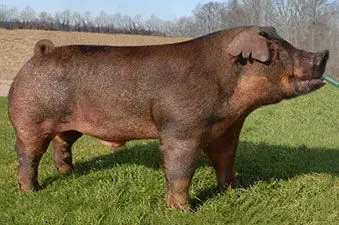New pig owners must know the average span of growth for most pig breeds out there in order to become fully prepared for changes and the steps they need to take! This post is going to be a guide about pig’s growth.
How quickly do pigs grow? On average, most pigs can grow and become fully matured at about six months of age. Pigs stop growing around 2 to 3 years of age. However, from 1 year of age, their growth may be unnoticeable because it starts slowing down.
There are certain breeds that have faster growth rates than the others but normally, six months is just about right for many farmers.
Some breeds also grow slower compared to other breeds which also resulted in a decline of population.
A pig’s size and weight can also heavily depend on their breed’s standard traits. However, there are times when a pig grows out of their breed’s expectations.
This is because pigs have
A pig’s growth can become unpredictable especially if they are deeply mixed.

Market pigs owners often sell pigs as soon as they are ready around six months old but pet pigs can continue to grow and live
There are also several factors that can affect a pig’s growth. One of those factors is the pig’s diet.
A pig’s diet can either stunt or accelerate a pig’s growth which is why it is important to always maintain a healthy yet balanced diet in order to sustain a proper growth rate and produce excellent results.
Another factor that affects a pig’s growth is their environment.
Depending on how a pig is raised, their growth can also differ. There are times when pigs will stop growing due to unhealthy living conditions but when pigs are kept under a healthy environment, they tend to follow a stable growth routine.
Market pigs often sell pigs as soon as they are ready around six months old but pet pigs can continue to grow and live
There are also several factors that can affect a pig’s growth. One of those factors is the pig’s diet.
A pig’s diet can either stunt or accelerate a pig’s growth which is why it is important to always maintain a healthy yet balanced diet in order to sustain a proper growth rate and produce excellent results.
Another factor that affects a pig’s growth is their environment.
Depending on how a pig is raised, their growth can also differ. There are times when pigs will stop growing due to unhealthy living conditions but when pigs are kept under a healthy environment, they tend to follow a stable growth routine.
Factors that Affect a Pig’s Growth
As mentioned above, there are indeed some factors that can affect a pig’s growth and we are going to explain them in detail.
- Genetics
- Diet
- Health
- Environment
- Selective Breeding
A. Genetics — plays the most natural part and truly affects growth more than anything else. A pig’s genetics can be diverse as many breeds have been naturally crossbred after many years of domestication.
B. Diet — a healthy and balanced diet can help accelerate growth in some pigs and can be really useful for certain farmers. Just like with people, a proper diet with pigs works wonders.
C. Health — there are certain cases when pigs can be born with medical complications and may lead to a delayed growth. It is normal and can happen in other animals including people too.
D. Environment — a clean and healthy environment will help enriching a pig’s overall health and can definitely boost or support a pig’s growth.
E. Selective Breeding — is the act of intentionally manipulating genetics in order to produce a favored new breed. Selective breeding may have a bad reputation for some, but there are good breeders out there.
When do Pigs Stop Growing?
Pigs stop growing around 2 to 3 years of age. However, from 1 year of age their growth may be unnoticeable because it starts to get slow.
This is why we always want to set the expectations for pig owners that not all pigs stay as small as it is as they can still grow twice their current size and weight during their first year of age.
Though there are breeds that are naturally small to medium in size, there is still no guarantee that they will stay within their breed’s standards.
As mentioned above, there are many factors that can affect a pig’s growth.
To provide some good ideas for potential new pig owners, we listed some interesting breeds for you to check that might capture your approval.
- Berkshire Pigs — one of the fastest growing breeds of pigs and mostly favored by farmers
- Meishan Pigs — can start breeding around 2 to 3 months of age
- Vietnamese Pot-bellied Pigs — naturally small breed of pigs that can stay within your standard of “small”
- Kunekune Pigs — also one of the naturally small breeds that can be raised as pets
- Gottingen Mini Pigs — are said to be one of the most successful breed of “miniature pigs” and can probably satisfy your standards for pets
The Cycle of a Pig’s Growth
After learning about their growth, it is only natural for people to wonder about the normal life cycle of a pig. Market pigs or pet pigs, we will explain it all in here.
Pet Pigs — Life Cycle
Often times, pet owners prefer to adopt weaned piglets. Piglets are usually weaned at around 21 days of age but it can still depend on the breeder.
Weaning means the process of turning piglets independent from their mother’s nursing and enabling them to eat on their own.
This way, they can be easier to care for and be raised without their mothers.
Starting from a young piglet, owners will begin to teach piglets their name and since pigs are intelligent animals, they can learn their names within two weeks of age meaning owners will only need another two weeks to learn a new name.
After that, the pet piglet should be able to adjust to an indoor lifestyle or backyard lifestyle if the owner sets it up for them.
Pigs grow and become matured at 6 months of age therefore if the owner is not planning to breed their pet pigs, they should spay and neuter their pet pigs.
Luckily for pet pigs, there is no limitation to their life cycle and they will be able to continue enjoying life as usual on a daily basis after settling down with their loving homes unlike farm pigs.
Farm Pigs / Market Pigs — Life Cycle
Pig pregnancy takes up to 3 months and a few more days. Pregnant pigs will be moved to a special area in order to give birth.
On an average, pigs are expected to give birth to 10 to 12 piglets but this can differ depending on a pig’s breed.
Upon giving birth, piglets will be weaned as early as 21 days of age.
When piglets are successfully weaned, they are then moved to a nursery with other piglets with a properly controlled temperature in order to monitor the sensitive health of a young pig.
Young pigs can grow up to 27 kilos at most but it can still depend on their breed.
Everything is set out smoothly as soon as a piglet has been properly weaned as they will just continue to be raised and fed by farmers to grow them as they wish.
Commonly, as soon as the pigs reach six months of age, they are big enough for the market.
Related Questions
What is the average life expectancy of a pig?
The life expectancy of an average pig can get up to 15 and 20 years. It’s very long compared to wild pigs which are known to live only up to 4 and 8 years.
Depending on their breed, the life expectancy could differ.
Certain breeds may be born with complications and special medical needs due to the way they were raised and bred. “Teacup” or “Micro” breeds are popular for its appearance, but are also known to have a short lifespan due to health problems.
This is why adopting is encouraged more than shopping to stop illegal breeders.
One factor that allows them to live longer than usual is how well they are cared for.
Pet pigs are always well fed and are provided with their needs, securing a healthy lifestyle for them.
Their environment could greatly affect their life too.
At times, pigs cannot handle extreme heat or extreme cold. They are prone to heat stroke and pneumonia if not monitored. Other sickness may affect them as well. There are reported incidents when pigs pass away due to the extreme weather conditions.
Sadly, pigs are slaughtered before they even reach their prime therefore they are deprived of half their life expectancy.
However, it is known that obesity is the most common health problem with pet pigs. It could cause a lot of health problems, therefore it is important to give them a properly balanced diet.
There are also cases where when a pig is raised alone, pigs can get lonely or depressed to the point of starving themselves to death.
For cases like this, it might be best to give your pig a companion to keep them happy in life.
Learn more about a pig’s life expectancy by clicking the blue texts.
- What are the breeds of small pigs?
There are still many small breeds of pigs and we listed the most common or popularly known ones for you to check.
Not only are they common, they are popular for their friendly characteristics!
One may think that they are all similar, but each breed could have their own unique traits and personalities. Owning any kind of pet is a huge responsibility and requires commitment.
Before deciding you want to adopt or buy a pig, it’s important to consider your compatibility with them.
